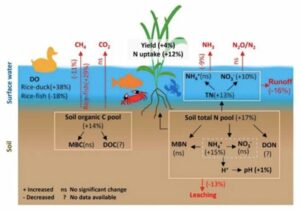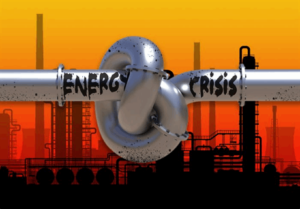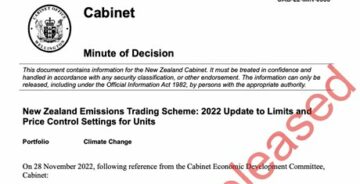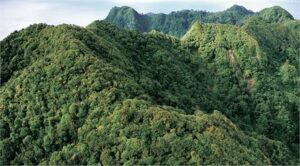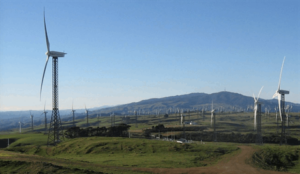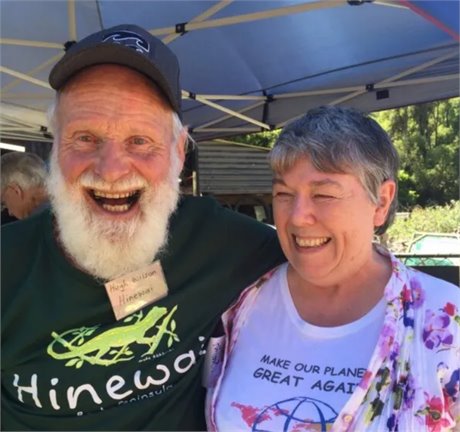 |
| Hugh Wilson (left), the inspirational and long-term manager of Hinewai Reserve, one of the first projects to earn carbon credits in New Zealand and Ann Smith (right). PHOTO: Ann Smith. |
By Ann Smith
By Ann Smith | COMMENT: Over the past few months, The Guardian has published five or more articles questioning the integrity of carbon offset projects that have been certified by well-known international organisations that issue carbon credits.
Over the past few months, The Guardian has published five or more articles questioning the integrity of carbon offset projects that have been certified by well-known international organisations that issue carbon credits. The investigation led by The Guardian focused on rainforest projects designed to prevent deforestation and degradation of existing mature forests, known as REDD+ projects. The articles questioned whether the threat to the forests had been overstated and raised concerns about human rights of the communities associated with the forests. These were referred to as ‘phantom credits’ that do not represent genuine carbon credits – a point I will return to later. The companies were described as using the ‘phantom credits’ to justify continuing to emit greenhouse gases with no reduction in gross emissions.
I talked in an earlier letter about two organisations claiming to have reduced emissions but the atmosphere sees only one reduction; in the case of ‘phantom credits’, there are emissions by one party and there may be no reduction by the other party – the atmosphere sees an increase in emissions and no reduction. The certification body, Verra, disputes the results of the investigation but has announced that it will phase out the current programme and bring in new rules by July 2025.
Carbon-neutral advertising claims
This week, the consequences of this public scrutiny became real. The headlines read “Adverts claiming products are carbon neutral by using offsetting face UK ban” published by The Guardian and “EU Parliament votes to clamp down on carbon-neutral claims backed by offsetting” published in Edie.
The United Kingdom Advertising Standards Authority is looking at ‘carbon neutral’, ‘net zero’, and ‘nature positive’ claims. They are introducing stricter enforcement around the use of these terms “unless they can demonstrate they really are effective”. I expect ‘effective’ means that the claim must be based on a recognised international standard and has been third-party verified. I would also like ‘effective’ to mean that the action that the project is based on is additional and makes a difference to the atmosphere.
The European Parliament proposes a new directive that will ban the use of generic environmental claims such as ‘environmentally friendly’, ‘natural’, ‘biodegradable’, and ‘eco’ unless they are supported by evidence. The lawmakers went much further when they considered environmental claims based on carbon offsetting. They introduced an actual ban on claims such as ‘CO2 neutral’ or ‘carbon neutral’. Crucially, only claims or labels based on recognised certification schemes or those established by public authorities will be accepted. The Minister who took the lead on this proposal expects the negotiations to be “rather short and quite constructive”.
Carbon offset programmes
The voluntary carbon market was established during the preparation for and operation of the Kyoto Protocol. The Gold Standard and Verra are the largest certifiers of carbon offset projects. They both issue carbon credits to certified projects and these can be traded in the voluntary carbon market. There are a number of other programmes that I won’t go into at this time. The International Carbon Reduction & Offset Alliance (part of the International Emissions Trading Association) has developed international best practice criteria for offset programmes. The certified projects must be ‘real’, ‘additional’, ‘measurable’, ‘permanent’, ‘independently verified’ and ‘unique’. Accredited programmes are listed on its website.
The Gold Standard is a standard and certification programme that issues Gold Standard Verified Emissions Reductions (GS VERs). An early version of the programme was developed in 2003 by the World Wildlife Fund (WWF), SouthSouthNorth and Helio International to allow Clean Development Mechanism projects under the Kyoto Protocol, that met additional sustainability criteria, to also operate in the voluntary market. The current voluntary programme was developed in 2006 through a consultation process overseen by an independent Standards Advisory Board which includes scientists, project developers and government representatives. The Gold Standard provides validation and verification requirements and approves third party organisations to undertake audits of project design and the greenhouse gas emission reductions or removals reported. Gold Standard certified carbon credits are issued to project owners in the GS Impact Registry which provides publicly available information that enables ownership and status of the carbon credits to be tracked.
The Verified Carbon Standard is a standard for certifying greenhouse gas emissions reductions or removals and was developed in 2005 by The Climate Group, IETA, The World Economic Forum (WEF) and the World Business Council for Sustainable Development (WBCSD). It is administered by Verra, a not-for-profit organisation. Verra provides validation and verification requirements and approves third party organisations to undertake audits of project design and the emission reductions and removals reported. Verified Carbon Units (VCUs) are issued to project owners in the Verra Registry which transparently lists information on certified projects and the units issued and retired.
To be eligible to apply for certification, a project must use a measurement methodology that has been approved by the certifying programme. Both programmes list approved project methodologies including energy- and technology-related projects; land-use, afforestation and agriculture-based projects; and wetland, coastal and marine restoration projects. Both programmes have mature governance structures and safeguards.
The Gold Standard has certified over 2,000 projects in nearly 100 countries. The all-time number of carbon credits issued represent 191 million tonnes of carbon dioxide emissions reduced or removed from the atmosphere. The Gold Standard estimates that the 40 million carbon credits issued in 2021 delivered US$5 billion in shared value. Verra has certified over 1,775 projects in seven regions. The all-time number of carbon credits issued represents 835 million tonnes of carbon dioxide emissions reduced or removed from the atmosphere. Around 300 million carbon credits were issued in 2021. Climate Trade reported that Ecosystem Marketplace’s annual survey on the voluntary carbon market revealed that some 500 million credits were traded in 2022 at an average price of US$4 per credit. This is a 60 percent increase over 2021. The value of the market exceeded US$2 billion in 2022.
There are also government programmes that certify offset projects and issue carbon units to projects operating in the voluntary carbon market e.g. in Australia, British Columbia, California, Chile, Japan and the United Kingdom.
New Zealand's source of carbon credits
Until recently, the main source of New Zealand carbon credits for voluntary offsetting was the government’s Permanent Forest Sinks Initiative. This programme sat outside the Emissions Trading Scheme but was issued New Zealand Units (NZUs). These units could be voluntarily cancelled in the New Zealand Emissions Trading Register by companies seeking to offset emissions and make a carbon neutral claim. Companies concerned about double counting against New Zealand’s international commitments under commitment period two of the Kyoto Protocol, could also cancel an Assigned Amount Unit (AAU) on the register. This effectively removed the unit from the national carbon accounts and ensured that double counting was not taking place. Whether or not a reduction in emissions was achieved is debatable because there was an excess of the Assigned Amount Units issued to New Zealand through the Kyoto Protocol. The Permanent Forest Sinks Initiative programme has been disestablished and replaced by the Permanent Post 1989 Forest which is a category within the Emissions Trading Scheme. This means it is effectively part of the Emissions Trading Scheme along side other non-permanent forest participation.
Government guidance on voluntary offsetting makes it clear that going forward, New Zealand Units should not be used for voluntary offsetting and the government will not provide the facility for cancellation of NZUs to be adjusted in the national carbon accounts. Under the Paris Agreement, this is known as a Corresponding Adjustment. The guidance makes it clear that cancelling a New Zealand Unit in the Emissions Trading Register does not guarantee that there has been a reduction in emissions. The Ministry for the Environment recommends that organisations do not use the cancellation of a New Zealand Unit as the basis for a voluntary offset claim. There are a number of different ways that companies can earn or be allocated a New Zealand Unit and there may be no emissions reduction associated with the unit. The Ministry for the Environment guidance explains these issues in detail. A submission made by Dr Christina Hood to the Parliamentary Select Committee reviewing free allocation of New Zealand Units to participants in the Emissions Trading Scheme revealed that some companies may have been allocated significantly more New Zealand Units than their actual emissions. These units if used for voluntary offsetting would effectively be ‘phantom units’ as discussed earlier in this letter.
Use of New Zealand Units to make a carbon neutral claim related to an export product, would not pass scrutiny under the new rules being established by the European Parliament and the United Kingdom Advertising Standards Authority. These developments will in due course impact on New Zealand export products labelled as carbon neutral, net zero or climate positive that go into the European and United Kingdom export markets. The good news is that New Zealand has a highly accredited body, Toitū Envirocare, able to certify carbon reduction and carbon neutral claims to recognised international standards but this is reliant on high quality overseas carbon credits.
There is no government endorsed framework for New Zealand projects to earn suitably certified New Zealand voluntary carbon credits. There is no voluntary carbon market in New Zealand that can be used by New Zealand exporters to take their carbon neutral products and claims into overseas markets. “Only claims or labels based on recognised certification schemes or those established by public authorities will be accepted by the European Union.” New Zealand companies with great emission reduction and removal initiatives are turning to the Gold Standard and Verra where it may take up to three years to take a project through their certification processes.
In a later letter, I will look at the international standards and the various guides that spell out what integrity means for future carbon credit projects, and carbon neutral and net zero claims.
=====
Read more from Dr Ann Smith in Letters from the Atmosphere, a regular newsletter looking at the science behind news stories on climate action.
- SEO Powered Content & PR Distribution. Get Amplified Today.
- PlatoAiStream. Web3 Data Intelligence. Knowledge Amplified. Access Here.
- Minting the Future w Adryenn Ashley. Access Here.
- Buy and Sell Shares in PRE-IPO Companies with PREIPO®. Access Here.
- Source: https://www.carbonnews.co.nz/story.asp?storyID=27754
- :has
- :is
- :not
- :where
- $UP
- 000
- 1
- 10
- 100
- 2005
- 2006
- 2021
- 2022
- 2025
- 40
- 500
- a
- Able
- About
- accepted
- Accounts
- accredited
- achieved
- Action
- actual
- Additional
- Adjusted
- Adjustment
- administered
- Advertising
- advisory
- advisory board
- against
- Agreement
- Alliance
- allocated
- allocation
- allow
- along
- also
- amount
- an
- and
- announced
- annual
- Apply
- approved
- ARE
- around
- articles
- AS
- assigned
- associated
- Association
- At
- Atmosphere
- audits
- Australia
- Authorities
- authority
- available
- average
- backed
- Ban
- based
- basis
- BE
- became
- because
- been
- behind
- being
- BEST
- Billion
- board
- body
- both
- bring
- British
- British Columbia
- business
- but
- by
- california
- CAN
- carbon
- carbon credits
- carbon dioxide
- Carbon Reduction
- Carbon-neutral
- case
- Category
- Certification
- Certified
- certify
- Chile
- claim
- claiming
- claims
- clamp
- clear
- Climate
- climate action
- CO
- Columbia
- comment
- commitment
- commitments
- committee
- Communities
- Companies
- concerned
- Concerns
- Consequences
- considered
- consultation
- continuing
- Corresponding
- could
- Council
- counting
- countries
- course
- credit
- Credits
- criteria
- crucially
- Current
- deforestation
- delivered
- demonstrate
- described
- Design
- designed
- detail
- developed
- developers
- Development
- developments
- difference
- different
- discussed
- disputes
- do
- Dock
- does
- double
- down
- due
- during
- e
- Earlier
- Early
- earn
- Economic
- Economic Forum
- ecosystem
- effectively
- eligible
- emission
- Emissions
- enables
- enforcement
- Environment
- environmental
- established
- estimates
- Ether (ETH)
- European
- European Parliament
- european union
- evidence
- exceeded
- excess
- existing
- expect
- expects
- Explains
- export
- Face
- Facility
- few
- First
- focused
- For
- forest
- Forum
- Forward
- Framework
- Free
- from
- fund
- further
- future
- GAS
- genuine
- Go
- going
- Gold
- Gold Standard
- good
- governance
- Government
- great
- greenhouse gas
- Greenhouse gas emissions
- gross
- Group
- guarantee
- guardian
- guidance
- Guides
- had
- Have
- Headlines
- High
- highly
- hood
- HTTPS
- human
- human rights
- i
- if
- Impact
- in
- includes
- Including
- Increase
- independent
- information
- Initiative
- initiatives
- Inspirational
- integrity
- International
- into
- introduced
- introducing
- investigation
- issue
- Issued
- issues
- IT
- ITS
- Japan
- jpg
- July
- Kingdom
- known
- Kyoto Protocol
- Labels
- largest
- later
- lawmakers
- lead
- Led
- left
- letter
- like
- List
- Listed
- Lists
- long-term
- Look
- looking
- made
- Main
- make
- MAKES
- manager
- Marine
- Market
- Markets
- mature
- May..
- mean
- means
- measurement
- mechanism
- methodologies
- Methodology
- million
- ministry
- months
- more
- much
- must
- National
- nearly
- negotiations
- net
- Neutral
- New
- New Zealand
- news
- Newsletter
- no
- normal
- number
- of
- offset
- on
- ONE
- only
- operate
- operating
- operation
- or
- organisation
- Organisations
- Other
- out
- outside
- over
- overseas
- owners
- ownership
- paris
- Paris Agreement
- parliament
- Parliamentary
- part
- participants
- participation
- party
- pass
- past
- percent
- period
- permanent
- phase
- Place
- plato
- Plato Data Intelligence
- PlatoData
- Point
- positive
- Post
- practice
- prevent
- price
- process
- processes
- Product
- Products
- programme
- programmes
- project
- projects
- proposal
- proposes
- protocol
- provide
- provides
- public
- publicly
- published
- quality
- Questioned
- raised
- Read
- real
- really
- recently
- recognised
- recommends
- Reduced
- reduction
- referred
- regions
- register
- registry
- regular
- related
- removal
- Removed
- replaced
- Reported
- represent
- Representatives
- represents
- Requirements
- Reserve
- restoration
- Results
- return
- Revealed
- reviewing
- right
- rights
- rules
- s
- safeguards
- scheme
- schemes
- Science
- scientists
- seeking
- sees
- seven
- shared
- Short
- should
- side
- significantly
- some
- Source
- SPELL
- standard
- standards
- Status
- Stories
- stricter
- submission
- such
- Supported
- Survey
- Sustainability
- sustainable
- Sustainable Development
- Take
- taking
- terms
- than
- that
- The
- The Guardian
- The Register
- the United Kingdom
- the world
- their
- There.
- These
- they
- Third
- third-party
- this
- those
- threat
- three
- Through
- time
- to
- took
- trade
- traded
- Trading
- transparently
- Turning
- two
- Uk
- under
- union
- unit
- United
- United Kingdom
- units
- use
- used
- using
- validation
- value
- various
- Verification
- verified
- version
- voluntarily
- voluntary
- votes
- was
- ways
- Website
- week
- WEF
- well-known
- went
- were
- What
- when
- whether
- which
- WHO
- Wildlife
- will
- Wilson
- with
- within
- world
- World Business
- World Economic Forum
- World Economic Forum (WEF)
- would
- years
- Zealand
- zephyrnet
- zero


